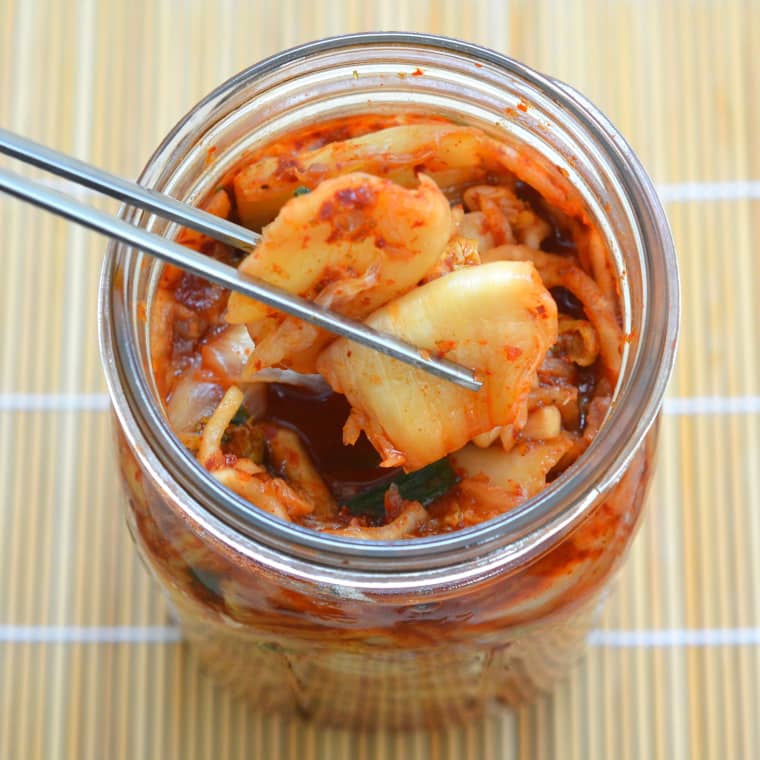
What is kimchi? Spicy fermented napa cabbage. It is a living food, preserving the nutrients of the vegetables going into it while self generating other health benefits.
What is in kimchi? It primarily consists of cabbage and salt but you can also include Korean radish/mu, scallions, sesame seeds, onions, garlic, ginger, Korean pepper flakes, fish sauce, baby brine shrimp, raw seafood, Asian pears/apples, and so much more depending on the kind of kimchi you want to prepare as different regions also prepare it differently.
What does it taste like? It is bright, briny, soured, and spicy. Not exactly, but kind of like a spicy sauerkraut. There are hundreds of different kinds and each one has its own special characteristics.
How do you serve it? Kimchi is a side dish that is present for every single Korean meal. Some people enjoy it like a salad while others enjoy it in a recipe. You can use well fermented kimchi as a topping for hot dogs, hamburgers, pizza or tacos to more traditional applications like kimchi stew or even a curried kimchi pancake.
What are some of its health benefits? It is high in fiber, probiotics, antioxidants, vitamins a, b, c, and calcium and iron while being low in calories and fat. A well-fermented kimchi has anywhere from 100 million to 1 billion bacteria of genus Lactobacillus.
How long does it last? My grandmother would have kimchi buried in the ground and some of it would be 2 years old or more. Film yeast was never a deterrent for her. My mother has a kimchi refrigerator that is specially climate controlled for preserving kimchi and hers tastes just right for up to 6 months or more. There are tons of debate on the matter but use your own discretion. It’s a good practice to regularly turn over the leaves of prepared kimchi and spoon over the juice to re-saturate leaves. It is after all, a controlled pickling environment. Over fermented kimchi is definitely an acquired taste and Koreans have a name for each stage the kimchi enters. Please use your discretion, sight, and smell.
Here are a few other noteworthy tidbits.
- Health.com listed kimchi as one of the top five healthiest foods in the world.
- Studies have shown that kimchi has compounds to fight and prevent the growth of cancer.
- When getting your picture taken in Korea, it’s customary to say “kimchi” instead of “cheese.”
- Koreans consume around 40 lbs or more of kimchi each year.
- When the price of napa cabbage rose in 2010, it was considered a ‘national crisis.’
- Kimchi is so adored in Korea, that they have an entire museum dedicated to it.

- 5 lb napa cabbage
- ½ c coarse sea salt {no substitutions for this recipe}
- ¾ c cold filtered water
- 3 tb sweet/glutinous rice {not regular rice} flour
- ¾ c Korean red pepper flakes- not regular red pepper flakes {adjust for less/more spicy}
- 3 tb fish sauce*
- ¼ c fresh garlic
- 1 tb fresh ginger
- ½ c vidalia onion
- Half of an Asian pear/fuji apple
- Extra additions: ½ c each of green onions/carrots/daikon/leeks/Chinese water celery/raw oysters, squid or fish/etc
- In a large bowl/basin, chop the cabbage in desired pieces, discarding any wilted/brown outer leaves. Sprinkle evenly with salt and toss to coat.
- Allow the cabbage to soak up the salt for an hour ½ to 2 hours, depending on how salty you like it. It’s important to toss and turn over the leaves every 30 minutes or so.
- Meanwhile, heat the water and stir in the sweet rice flour. Cook until the mixture gets thick, smooth, and milky. Set aside.
- In a food processor, add the fish sauce, garlic, ginger, onion, and pear. Pulse to puree.
- To the cooled sweet rice flour mixture, stir in the Korean red pepper flakes and pureed mixture. This will be your kimchi paste.
- After the cabbage has finished soaking, rinse several times and drain well.
- In a large bowl, carefully begin coating the cabbage with your paste. Add in your veggies. Toss to coat, taking care not to squeeze the leaves. If using, this is the time to gently add in your raw seafood.
- Mix until everything is nicely coated. Transfer the kimchi to glass containers/bpa free plastic containers and gently press down and seal.
- Allow the containers to sit at room temperature for 1-2 days to jumpstart fermentation then refrigerate.
Recommended:
Fish Sauce: http://amzn.to/1DrltVM
Sweet Rice Flour: http://amzn.to/1wfcUYT
Love,
Your Squishy Monster